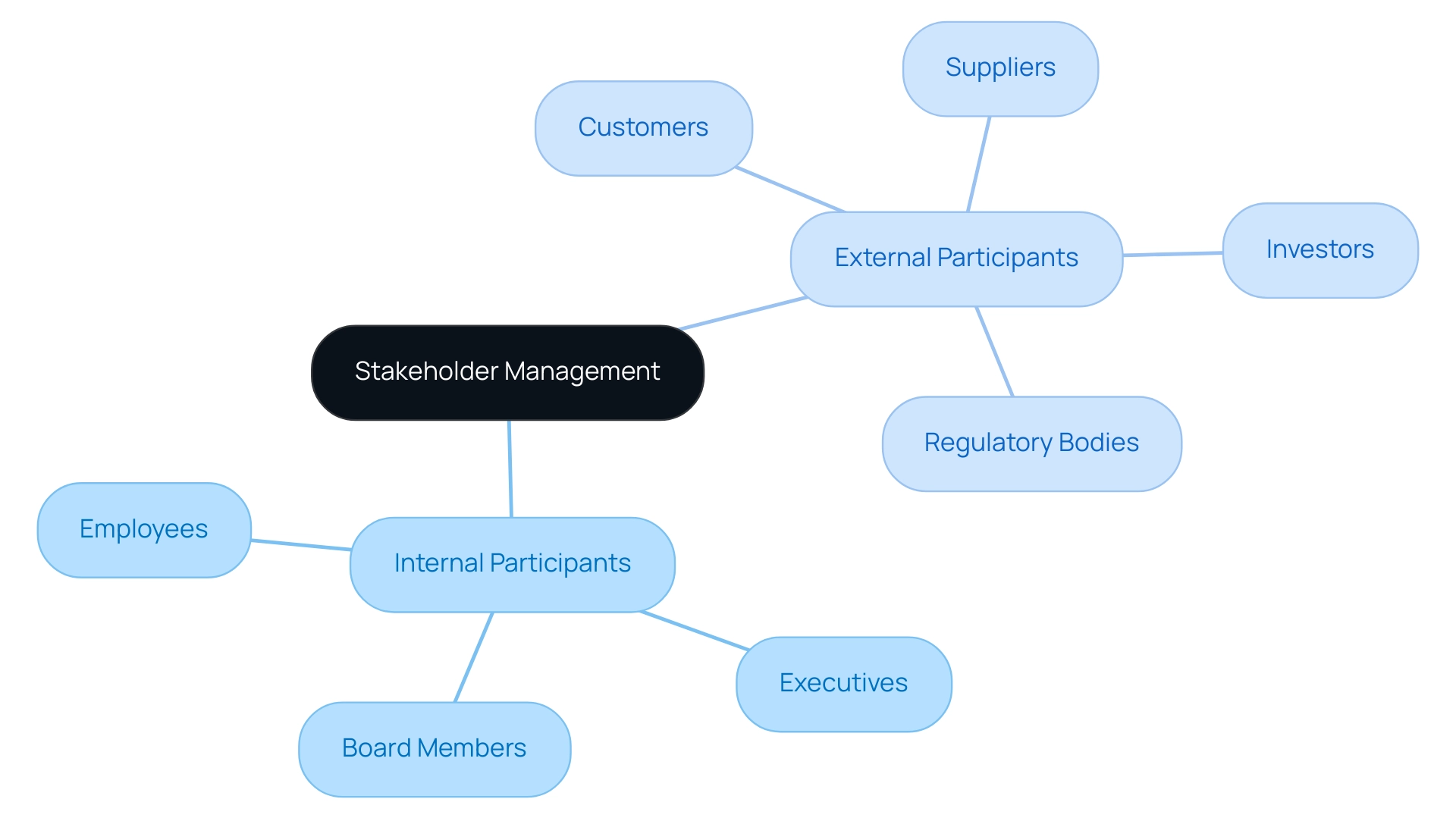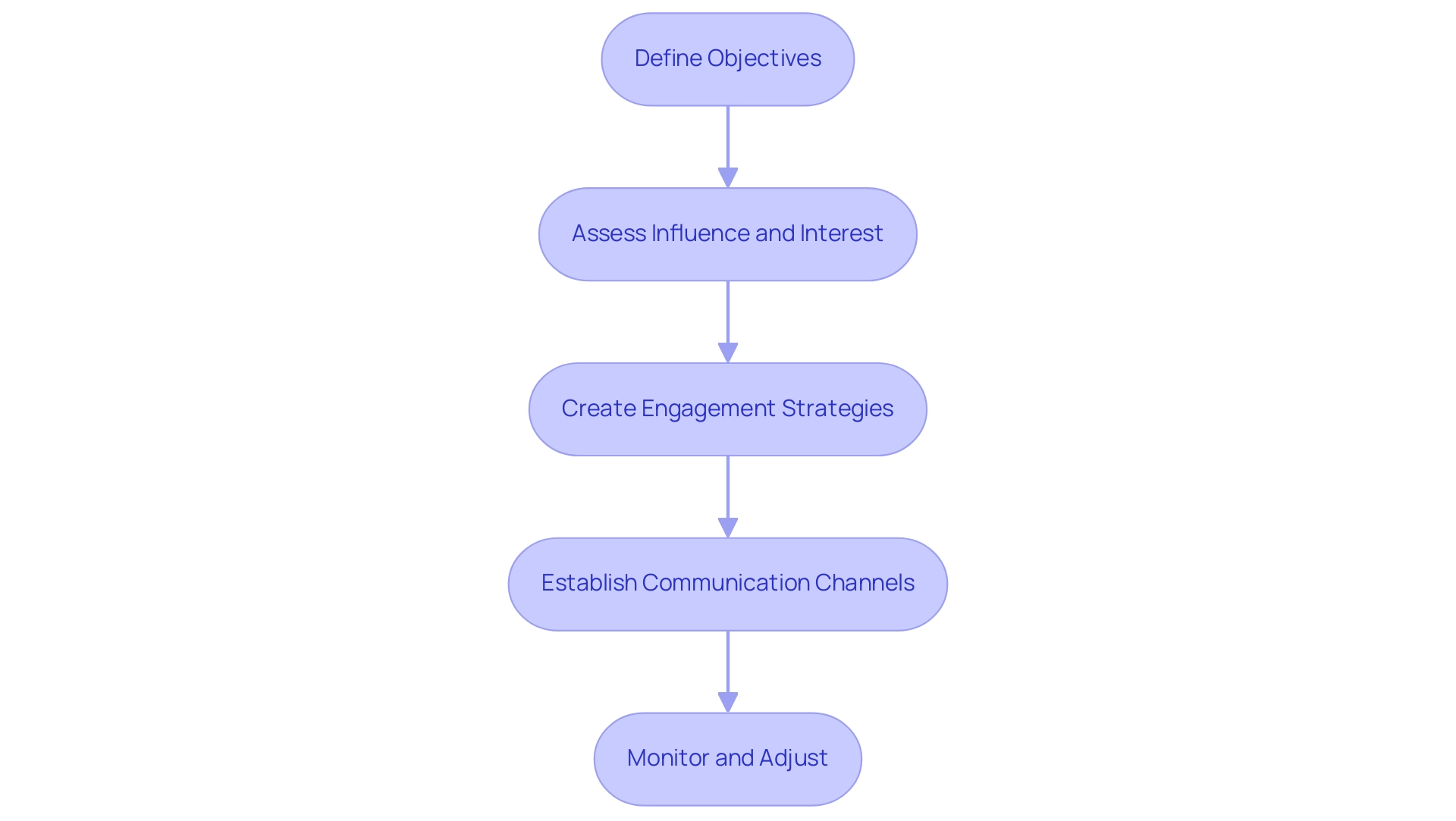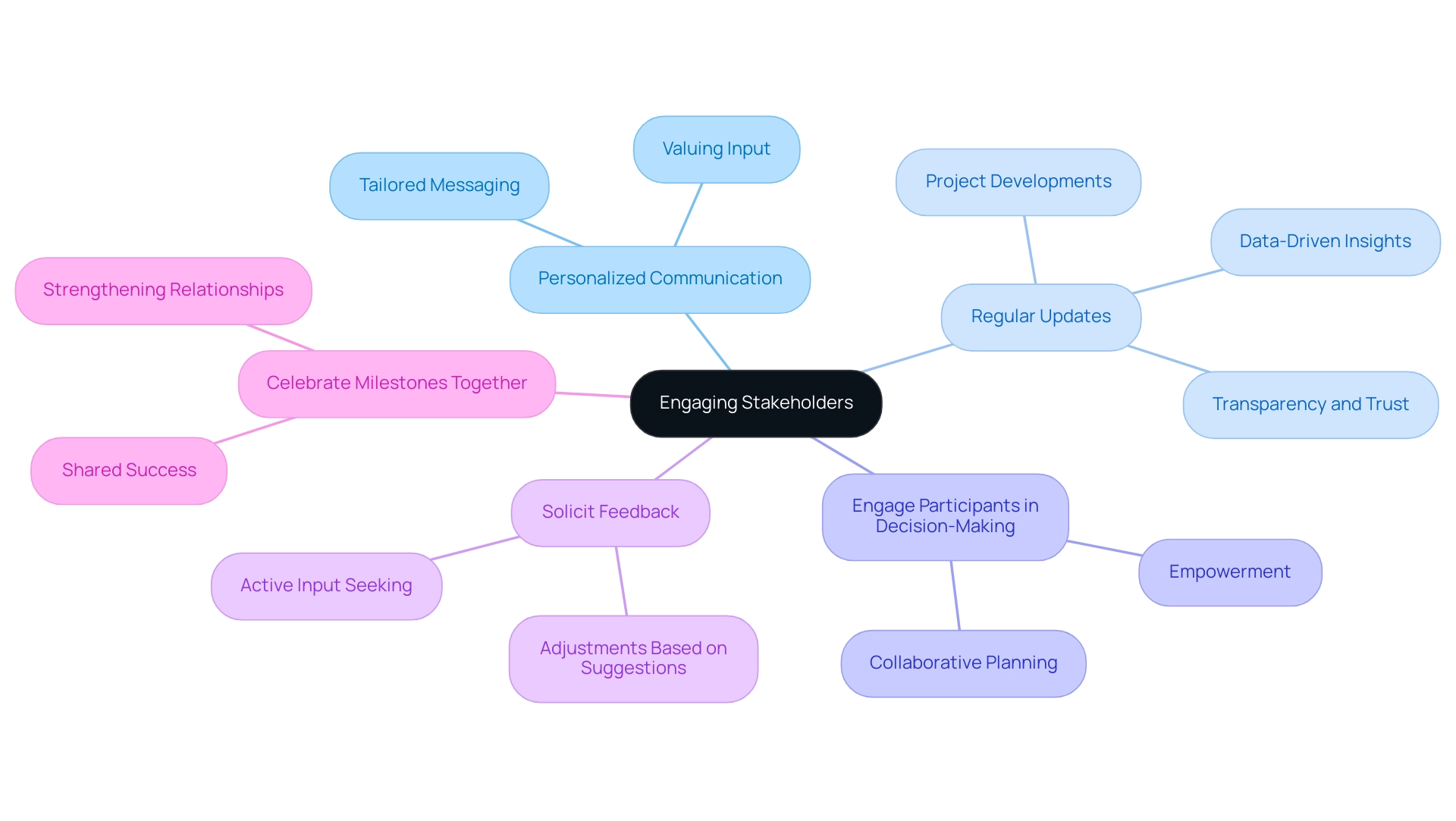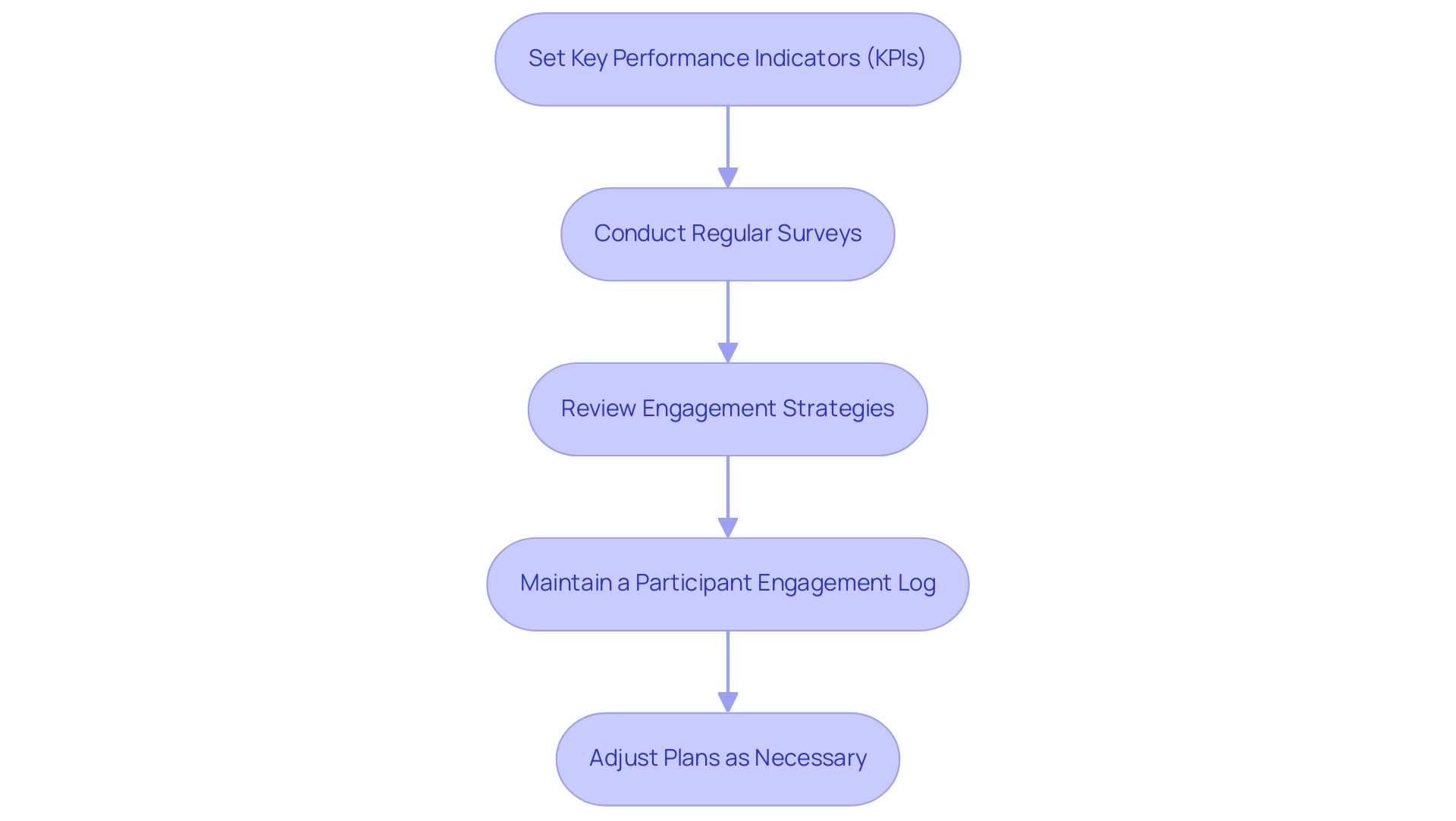Introduction
In the dynamic landscape of business, effective stakeholder management emerges as a cornerstone for success. Identifying and engaging key stakeholders not only enhances communication but also fosters collaboration that can drive initiatives forward.
This article delves into the essential steps of stakeholder management:
- Pinpointing influential parties
- Crafting tailored engagement strategies that resonate
By implementing a structured approach, organizations can ensure that they harness the collective insights and support of their stakeholders, paving the way for sustainable growth and mutual success.
Identifying Key Stakeholders: The First Step in Stakeholder Management
To plan stakeholder management, start by identifying essential participants and listing all individuals and groups that have an interest in or are impacted by your organization's activities. This encompasses internal participants such as:
- Employees
- Executives
- Board members
Along with external parties like:
- Customers
- Suppliers
- Investors
- Regulatory bodies
Conduct interviews or surveys to gather insights about their interests and influence on the organization.
Consider using a mapping tool to visualize relationships and prioritize participants based on their level of impact and interest. This essential step ensures that you plan stakeholder management by involving the appropriate individuals throughout the engagement process.

Developing a Comprehensive Stakeholder Management Plan
To create a comprehensive management plan for involved parties, follow these steps:
- Define Objectives: Clearly outline what you aim to achieve with your collaboration with interested parties. This could include improving communication, gaining support for initiatives, or addressing concerns.
- Assess Influence and Interest: Utilize the map created earlier to evaluate each individual's influence and interest levels. This will assist in prioritizing your involvement efforts.
- Create Engagement Strategies: For each key participant, develop tailored engagement strategies. This could involve regular updates, one-on-one meetings, or review sessions.
- Establish Communication Channels: Determine the most effective communication methods for each audience group, ensuring that information flows smoothly and transparently. Consider reaching out for more information about best practices—let's talk! Let's talk! Let's talk!
- Monitor and Adjust: Regularly review the effectiveness of your management plan and be prepared to modify strategies as needed based on feedback from involved parties and changing circumstances. This proactive method ensures that you plan stakeholder management effectively, keeping interested parties involved and supportive of your initiatives.
For further inquiries, feel free to contact SMB Turnaround at +1 (239) 428-9074 or visit us at 3200 Bailey Ln, Naples, FL 34105. As guided by Peter Griscom, we are dedicated to improving your engagement with interested parties.

Engaging Stakeholders: Building Relationships
To effectively involve interested parties, consider the following strategies:
- Personalized Communication: Tailor your communication to meet the specific needs and preferences of each individual involved. This shows that you value their input and fosters a sense of partnership.
- Regular Updates: Keep interested parties informed about project developments and changes. Schedule regular check-ins or updates to maintain transparency and build trust. Utilize real-time business analytics from your client dashboard to provide data-driven insights during these updates.
- Engage Participants in Decision-Making: Where suitable, engage key participants in the decision-making process. Our commitment to a shortened decision-making cycle enables involved parties to take decisive action, empowering them while ensuring their concerns and insights are considered. This collaborative planning process is essential to effectively plan stakeholder management for addressing underlying business issues.
- Solicit Feedback: Actively seek input from interested parties and demonstrate that you are listening by making adjustments based on their suggestions. This reinforces their importance in the process and strengthens collaborative efforts.
- Celebrate Milestones Together: Acknowledge and celebrate project milestones with involved parties. This creates a sense of shared success and strengthens relationships, operationalizing the lessons learned throughout the project.

Monitoring Stakeholder Engagement: Measuring Success
To track participant involvement effectively, implement the following practices:
- Set Key Performance Indicators (KPIs): Establish KPIs to assess the success of your participant involvement efforts. This could encompass measures such as participant satisfaction, interaction frequency, and response quality.
- Conduct Regular Surveys: Utilize surveys to collect opinions from participants regarding their degree of involvement and satisfaction. Analyze the results to identify areas for improvement and adjust your strategies accordingly.
- Review Engagement Strategies: Periodically assess the effectiveness of your engagement strategies. Are they yielding the desired results? Utilize real-time analytics from your client dashboard to inform these evaluations and be prepared to pivot if certain approaches are not working. This approach supports a shortened decision-making cycle, allowing for swift adjustments.
- Maintain a Participant Engagement Log: Keep a record of all interactions with participants, including meetings, feedback received, and follow-up actions. This log will help you track progress and ensure accountability while supporting the operationalization of lessons learned.
- Adjust Plans as Necessary: Based on your monitoring activities and the insights gained from continuous business performance analytics, be willing to adjust your plan stakeholder management. Flexibility is key to maintaining positive relationships and achieving your objectives, as well as operationalizing the lessons learned from your engagement efforts.

Conclusion
Effective stakeholder management is not just a strategic advantage; it is a necessity for any organization aiming for sustainable growth. The journey begins with identifying key stakeholders—both internal and external—who can influence or be influenced by your initiatives. By utilizing tools like stakeholder mapping and conducting insightful interviews, organizations can prioritize their engagement efforts and ensure that the right voices are heard.
Once stakeholders are identified, a comprehensive management plan becomes crucial. This involves:
- Defining clear objectives.
- Assessing the influence and interest of each stakeholder.
- Developing tailored engagement strategies.
Establishing effective communication channels and being willing to adapt based on feedback ensures that stakeholders remain engaged and supportive. Regular updates and involving stakeholders in decision-making not only build trust but also foster a collaborative environment that can lead to innovative solutions.
Finally, monitoring and measuring the success of stakeholder engagement efforts solidifies the foundation laid by previous steps. This includes:
- Setting KPIs.
- Conducting surveys.
- Maintaining a detailed engagement log.
These actions allow organizations to track progress and adjust strategies as necessary. This proactive approach ensures that stakeholder relationships are not only maintained but strengthened over time.
In conclusion, effective stakeholder management is a continuous process that requires attention and commitment. By strategically engaging stakeholders and being responsive to their needs, organizations can create a collaborative atmosphere that drives initiatives forward, ultimately leading to shared success and sustainable growth. The time to take action is now—engage your stakeholders and unlock the potential for transformative results.
Frequently Asked Questions
What is the first step in planning stakeholder management?
The first step is to identify essential participants and list all individuals and groups that have an interest in or are impacted by your organization's activities, including both internal participants (like employees, executives, and board members) and external parties (such as customers, suppliers, investors, and regulatory bodies).
How can I gather insights about stakeholders' interests and influence?
You can conduct interviews or surveys to gather insights regarding stakeholders' interests and their influence on the organization.
What is the purpose of using a mapping tool in stakeholder management?
A mapping tool helps visualize relationships and prioritize participants based on their level of impact and interest, which is essential for effective stakeholder management planning.
What are the key steps to create a comprehensive management plan for stakeholders?
The key steps include: 1. Define Objectives: Outline what you aim to achieve with stakeholder collaboration. 2. Assess Influence and Interest: Evaluate each individual's influence and interest levels using the mapping tool. 3. Create Engagement Strategies: Develop tailored strategies for each key participant. 4. Establish Communication Channels: Determine effective communication methods for each audience group. 5. Monitor and Adjust: Regularly review and modify your management plan based on feedback and changing circumstances.
What strategies can be used to effectively involve interested parties?
Effective strategies include: 1. Personalized Communication: Tailor communication to meet individual needs. 2. Regular Updates: Keep stakeholders informed about project developments. 3. Engage Participants in Decision-Making: Involve key participants in decision-making processes. 4. Solicit Feedback: Actively seek input and make adjustments based on suggestions. 5. Celebrate Milestones Together: Acknowledge and celebrate project milestones with stakeholders.
How can I track participant involvement effectively?
To track involvement, implement the following practices: 1. Set Key Performance Indicators (KPIs) to assess success. 2. Conduct Regular Surveys to collect participant opinions. 3. Review Engagement Strategies to evaluate effectiveness. 4. Maintain a Participant Engagement Log to track interactions. 5. Adjust Plans as Necessary based on monitoring and insights gained.




